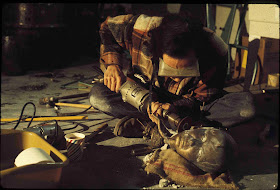I came across these images while organizing the complete slides of the late sculptor Michael Price for his wife, Susan Davis Price. Price was a figurative sculptor who was influenced by Marino Marini and Giacomo Manzu and whose work was often inspired by scripture. He worked in clay, and like every sculptor written about on this blog, he knew how to cast his original clay pieces into plaster and bronze, and he did it himself (in a foundry he built by hand), often with the help of the students he taught at Hamline University in Saint Paul, Minnesota, where he lived.
Shot in October and November of 1971 with beautiful Ektachrome slide film, these images show Price in nearly every stage of the 6,500-year-old process known as lost wax investment casting. Inevitably, they also show Mike's characteristic good humor and sweet personality.
Click on photos to enlarge.
Early in the process, Price melts the wax, applies it to the inside of a rubber mold, and inserts pins into the cast wax head.
Shot in October and November of 1971 with beautiful Ektachrome slide film, these images show Price in nearly every stage of the 6,500-year-old process known as lost wax investment casting. Inevitably, they also show Mike's characteristic good humor and sweet personality.
Click on photos to enlarge.
Early in the process, Price melts the wax, applies it to the inside of a rubber mold, and inserts pins into the cast wax head.
Here, Price encases the wax in an investment mold, made of plaster, silica and sand, and wraps it tightly with chicken wire.
At this point, the investment mold is placed in a kiln for several days and heated ("burnt out"). This stage melts the wax and burns out the carbon, creating a void that will filled by the molten bronze.
The bronze, heated to 2,100 degrees Fahrenheit, is poured into the investment mold.
When the bronze has cooled and has been broken out of its investment mold, we see Price chasing, welding, and grinding to prepare the piece for its final state.
Lastly, Price applies a chemically-induced color, called a patina, to the near-finished bronze.
See more images from this collection on our Flickr page.
Learn more about lost wax investment casting here.
Thanks to Susan Davis Price for the use of these images.
















I once carried lots of Michael Price’s bronzes from a second floor uptown gallery on Madison Avenue into a rented van where we were transporting them to a show at Haverford College. It was me, Jeff Nagle, and Chris Cairns, but Jeff and I were doing all the carrying. Life-sized bronzes are heavy and despite their padded wrapping, sharp. The memorable thing about that day had to do with their sharpness.
ReplyDeleteAt some point, I decided that I should get my gloves that I’d left in my backpack in the van. I slipped out to the van, and as I opened my backpack on the front seat I felt the presence of someone behind me. I looked across the van and saw another figure staring through the driver’s window at me. I don’t remember if words were exchanged, but I had the sense that I should remove my hands from my backpack slowly, which I did extracting my gloves. There was a relaxing and the presence behind me backed off, but the one at the other side of the cab continued to watch me carefully. I saw that he was wearing an ear-piece with a coiled cord tucked into his collar. As I got out of the van I saw that there were four or five other big guys with ear-pieces on the street watching me carefully. I looked into the first floor antiquities gallery across from me and saw a large man with an eye-patch shaking hands. Moshe Dayan! In the blink of an eye a car materialized and he was out the door, and they all swept away.
I think about this whenever I see the life-sized Michael Price figure that stands in front of a fire station in Allentown near Muhlenberg College.